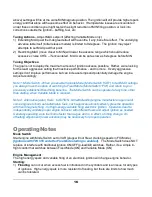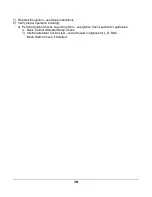
15
i) When the engine is rotated the wrong direction.
ii) If ignition DIR does not match engine rotation.
iii) When Mode Switch is in FIX position and engine is moving at hand pull-thru speeds.
iv) Plugs fire only once per cycle. You cannot back up and fire them again. Keep pulling thru
in the normal direction.
Note 2: Multi-Strike. At cranking speeds, the ignition uses a (5) rapid strike sequence for each
bank. This means the Pull-Thu Test will not produce
the familiar single spark “click”. Instead, you’ll
hear the plugs “buzz” - the sound of a multi-strike sequence.
Note 3: Due to the variety of engine and ignition configurations, it may be necessary to swap the
plug wire to cylinder (Banks B and C) assignments to achieve proper firing
– per the engine
manufacturer firing order.
Note 4: Pull-Thru firing positions cannot be used to verify ignition tracking accuracy. It only confirms
proper wiring and circuit assignments.
Tuning MAX
Orientation:
Operating the ignition in Variable Mode (Mode
Switch “VAR”) can improve engine efficiency by
enabling automatic adjustment of the plug firing advance. The range of automatic adjustment is
capped by the MAX setting. MAX will be either the default (9-degrees ahead), or a lesser MAX
position (as low as 6-degrees ahead) as set
by the operator. The default MAX setting is thought to
be a relatively conservative setting, especially when a Mode Switch installed, and the operator can
change to Fixed Mode at any time.
Operators can monitor VAR mode cruise conditions
(RPM above 2400 and MAP 22” or below)
where spark advance is greatest and be
mindful of the engine manufacturer
’s temperature
recommendations and red lines. It should be understood that improving efficiency (extracting more
energy from a given amount of fuel
) means a certain amount of additional heat may be generated.
Operators can anticipate VAR mode advanced firing will cause CHTs to rise by some increment
and EGTs to fall by some increment.
As a
GENERAL FRAMEWORK ONLY,
tuning VAR mode operations (MAX adjustments) can be
guided by engine efficiencies (airspeed/fuel-flow) and CHTs at cruise power settings
– keeping in
mind the limitations of CHT readings. Ignition advance is a significant, but not the only factor
influencing CHTs. Baffling, mixture, prop, cylinder design, cylinder break-in, air temperature, air
density, humidity, fuel type, induction boost, and more can all affect the indicated CHT. Every
installation should be considered unique
– assume nothing.
Establish a baseline
An initial period of operation in Fixed Mode (Mode
Switch to “FIX” after start-up) will allow you to
establish an operating baseline with plug firing at the manufacturer
’s recommended (magneto)
firing position. Similarly, Variable Mode operation at high power (higher RPM and
MAP 25” and





























